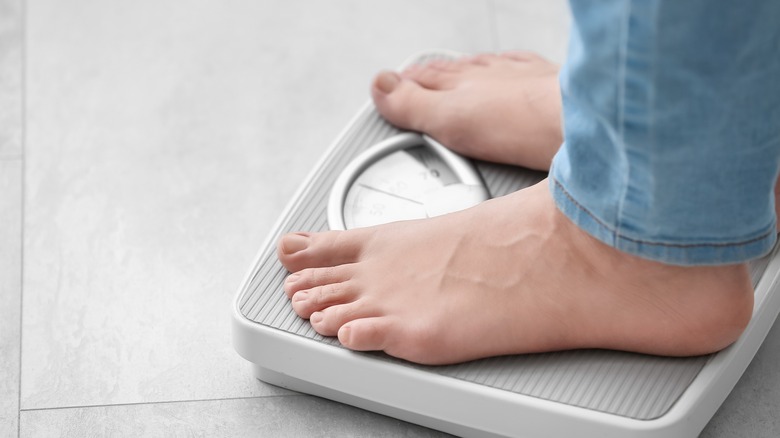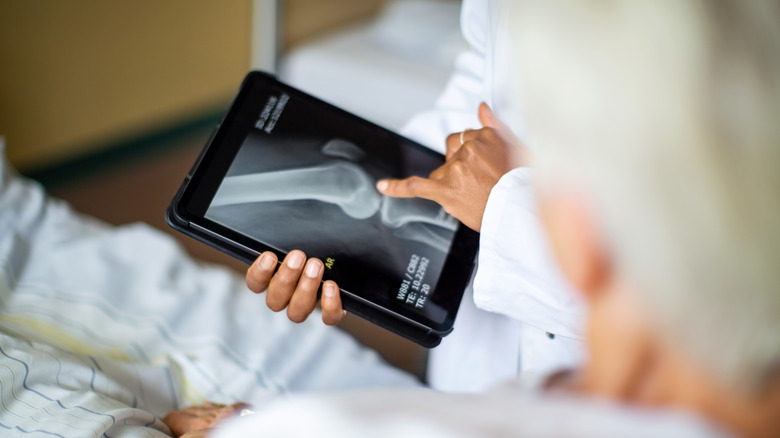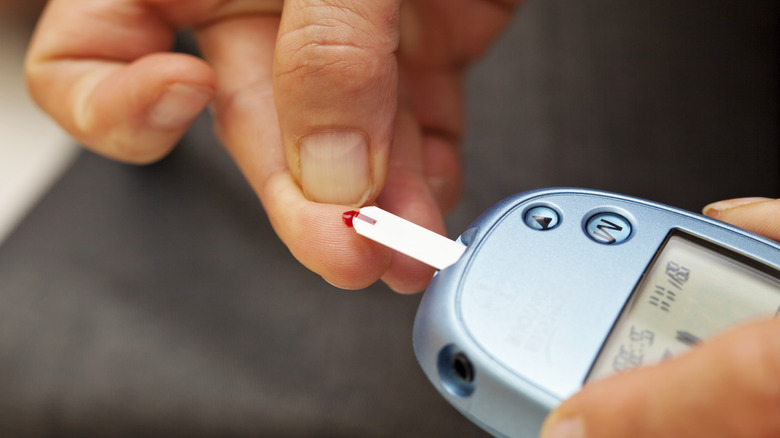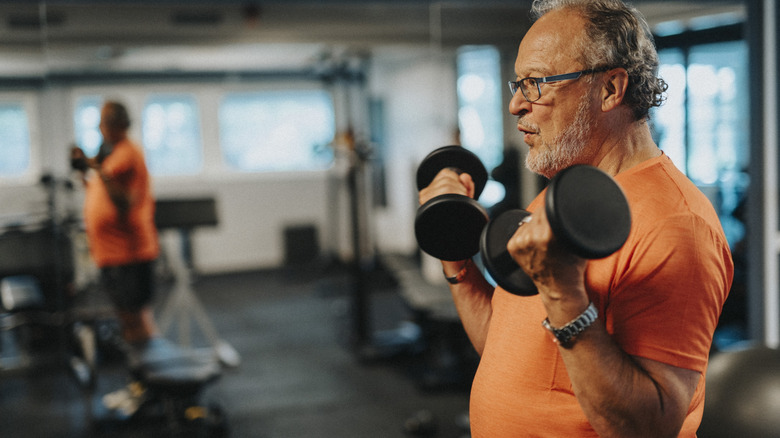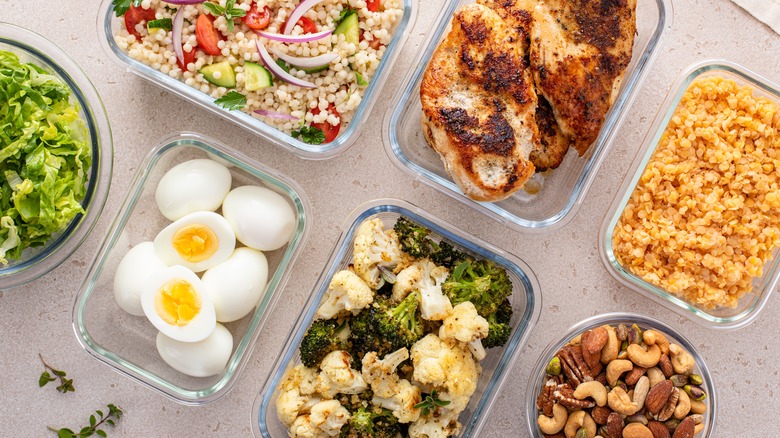When You Eat 50 Grams Of Protein At Every Meal, This Is What Happens To Your Body
In today's world, everyone seems to be fussing about eating more protein. While research keeps proving that there's no single right way to approach nutrition and that there are numerous paths toward healthy eating, including protein at every meal does have its advantages. Some of these include improving body composition, enhancing muscle strength, and even reducing risk factors for chronic diseases like diabetes and hypertension. Yet, these benefits seem to rely on how much protein you consume, highlighting the advantages of a high-protein diet (HPD).
You see, the amount of protein you should eat per day varies depending on multiple factors, such as your age, gender, weight, and whether you lead a physically active or sedentary lifestyle (via Healthline). For example, according to a review published in the Journal of the International Society of Sports Nutrition (ISSN), the recommended daily allowance (RDA) for protein is merely 0.8 grams/kilogram/day. However, evidence suggests that consuming 3 or more grams/kilogram/day (considered to be an HPD) might be what's needed to reap the previously mentioned benefits. At this rate, an average adult weighing 70 kilograms would consume 210 grams of protein daily, or roughly 50 grams divided into four daily meals. Still, it is important to note that many of the health benefits of an HPD have mainly been studied in athletes, which begs the question of whether they also apply to the general population. This article takes a closer look at the potential benefits of consuming 50 grams of protein at every meal, as well as easy ways to achieve it.
It might enhance muscle strength
According to a review published in the Journal of the ISSN, increasing your daily protein intake may have a positive impact on muscle strength, an effect derived from the role this nutrient plays in building and maintaining muscle mass. When it comes to muscles, proteins provide the materials needed to support their growth, repair, and recovery. These materials are called amino acids, although they are more commonly referred to as building blocks (per Medical News Today), and consuming them in sufficient quantities through protein-rich foods ensures that not only your body's tissues and systems function correctly but that your muscles can withstand greater resistance. This is because when you engage in strength training, muscle fibers experience microtears, and consuming enough protein helps repair these tears, promoting muscle growth and increased strength.
For instance, the review examined the results from 22 studies involving 680 people and found that when people increased their protein intake through supplements and combined it with resistance training like weightlifting, their lower-body strength increased by 13.5 kilograms, or about 30 pounds. However, the effect depends on protein intake being paired with strength training, as well as other influencing factors like intensity, quantity, and progression, and not on high protein consumption alone.
Your body composition may improve
When talking about body composition, you may come across terms like fat mass and fat-free mass (FFM) and discover that they are both subject to change when gaining or losing weight. As its name suggests, fat mass refers to your body's fatty or adipose tissue. In contrast, FFM refers to all the remaining elements that make up your body weight, such as your muscles, bones, organs, and body water (via InBody). As you can imagine, a healthy body composition is one where your fat mass is lower than your FFM. However, when people lose weight, they might find that the weight they lost came from their FFM instead, leaving them with not only a higher fat mass to FFM ratio but an increased risk of a post-weight loss weight regain, as explained by an article published in the Journal of Obesity and Metabolic Syndrome.
Luckily, it is widely known that an HPD, which can be achieved by eating 50 grams of protein per meal, can significantly impact your body composition for the better by helping reduce fat mass while keeping your FFM intact when trying to lose weight (via Healthline). Still, a study published in Advances in Nutrition notes that to do so, your weight loss efforts should also include strength training to maintain muscle mass and improve muscle strength.
You might lose weight
While eating 50 grams of protein per meal might seem like a lot of food, it might actually be the weight loss key you were looking for, seeing that, according to research, the nutrient participates in multiple mechanisms that boost metabolism and control hunger. Per an article published in the Journal of Obesity and Metabolic Syndrome, one such mechanism is its effect on the hunger-inhibiting hormones glucagon-like peptide-1 (GLP-1), cholecystokinin (CCK), and peptide tyrosine-tyrosine (PYY), and the hunger-inducing hormone ghrelin. You see, HPDs can increase your feelings of fullness by elevating GLP-1, CCK, and PYY levels while reducing ghrelin levels, ultimately leading to decreased food intake.
Another weight-loss-friendly mechanism is protein's effect on energy expenditure through diet-induced thermogenesis (DIT). The article explains that DIT is the energy your body uses to perform nutrient-related tasks, such as absorbing, metabolizing, and storing them. According to a review published in Advances in Nutrition, protein increases DIT by 30%, a higher energy expenditure than the 10% and 5% provided by carbs and fats, respectively. This higher energy expenditure can support fat burning throughout the day while keeping your hunger levels at bay. Lastly, protein's satiating and energy expenditure effects vary depending on the type of protein consumed, with plant-based proteins being more filling while animal-based proteins providing a higher DIT. Thus, make sure to vary your protein choices from time to time to get the best of both.
It might support your bones
Contrary to popular belief, packing your meals with 50 grams of protein might support rather than deteriorate bone health due to protein's numerous effects on bone metabolism. For starters, per a review published in Advances in Nutrition, protein benefits bone mineralization by increasing calcium absorption, an essential mineral for strong bones. This is possible because when you eat protein, your stomach produces more gastric acid, and its acidic pH makes it easier for your body to absorb the calcium you consume. Furthermore, protein intake also reduces the amount of parathyroid hormone in your body. By doing so, not only do your intestines get to absorb higher amounts of calcium, but it also reduces bone resorption, the process by which your body breaks down bone tissue to release calcium into your blood.
In addition, dietary protein boosts insulin-like growth factor 1 (IGF-1) production, a hormone that's also linked to bone metabolism because it promotes the activity of bone cells called osteoblasts, which are in charge of producing, strengthening, and repairing bone tissue to maintain a healthy bone structure. Lastly, according to a review published in Current Opinion in Clinical Nutrition and Metabolic Care, protein also benefits bone health by boosting muscle mass growth. This is because when doing strength training activities, your muscles, which are attached to your bones, create stress on them, leading to the activation of the previously mentioned osteoblasts (via Harvard Health Publishing).
It might improve insulin resistance
Insulin is a hormone produced by the pancreas that is key for blood sugar control. It is in charge of keeping blood sugar levels in check by transporting sugar from the bloodstream into the cells, where it can be used as an energy source. Yet, in some cases, cells and tissues in the body stop responding to insulin or become less sensitive to its effects, a condition known as insulin resistance (via the Centers for Disease Control and Prevention (CDC)). Insulin resistance leads to increasingly higher blood sugar levels, which, over time, can increase the risk of developing prediabetes and type 2 diabetes. Fortunately, the CDC states that insulin resistance can be reversed with lifestyle changes such as losing some weight, and an HPD can help with both.
According to a study published in Nutrients, an HPD worked better at lowering insulin resistance and controlling blood sugar levels than the Mediterranean diet in 16 obese women with prediabetes. Additional animal and human studies have shown similar results, per an article published in Physiological Reports, which states that the effect comes from the insulinotropic effects of amino acids that directly modulate pancreatic beta cells. In simpler terms, this means that dietary protein can promote insulin secretion by influencing the cells in the pancreas responsible for its production. Ultimately, this insulin boost would help clear out the excess blood sugar in your blood.
Your blood pressure might improve
High blood pressure or hypertension happens when the force of blood against the walls of your arteries is too strong, which might put them at risk in the long run. This can happen for numerous reasons, including non-modifiable factors like age, ethnicity, or genetics and modifiable factors like physical activity levels, body weight, and alcohol and sodium intake (via Healthline). When your blood pressure is checked, you receive two numbers. The top number indicates your systolic pressure, while the bottom indicates your diastolic pressure. Ideally, your systolic pressure should be below 120 millimeters of mercury (mmHg), and your diastolic pressure should be below 80 mmHg. According to the site, having a blood pressure above 130/80 mmHg means you are in the early stages of hypertension.
Since hypertension is a risk factor for heart disease, managing it before it gets out of hand is key, and evidence suggests that adding more protein to your diet might help reduce your blood pressure readings. According to a study published in the American Journal of Hypertension, eating more protein was linked to lower systolic and diastolic blood pressure readings, regardless of whether it came from animal- or plant-based sources. Plus, another study published in the Journal of Human Hypertension shared interesting results by determining that after an initial weight loss-induced blood pressure reduction in 420 people with obesity, a HPD assisted in keeping blood pressure readings low. Thus, eating 50 grams of your favorite protein-rich foods at every meal might be just what your heart needs.
It might prevent muscle loss in older adults
Gradual muscle loss in older adults, known as sarcopenia, can affect the daily lives of people over 60 by increasing their risk of falls and fractures, thereby hindering their ability to perform routine activities and maintain independence in later life stages (via the Cleveland Clinic). Early signs of sarcopenia include weakened muscles, loss of energy to complete daily tasks, loss of balance leading to falls, and a slow but noticeable reduction in muscle size. While they may go easily unnoticed at first, early detection or prevention altogether is key to reducing frailty, the risk of adverse health-related outcomes, and improving quality of life, and one way to do it is by increasing protein intake per meal.
According to a study published in Current Opinion in Clinical Nutrition and Metabolic Care, a protein intake of at least 30 grams per meal can help older adults slow down muscle loss and maintain strength and mobility. A review published in The Journal of Human Nutrition and Dietetics reached similar conclusions, stating that a protein intake ranging between 30–40 grams per meal could maximize muscle protein synthesis and contribute to sarcopenia prevention, meaning that at 50 grams per meal, you'd be more than covered. Plus, the researchers determined that an efficient way to do so could be by increasing protein consumption at breakfast and lunch, which tend to be the meal times containing less protein in this specific population.
It might affect endurance performance for endurance athletes
As an article published in Progress in Molecular Biology and Translational Science explains, carbs are the body's primary energy source during exercise, seeing that they provide readily available energy from the glycogen stored in your muscles and the liver. Thus, if you're an endurance athlete, increasing your protein intake per meal at the expense of carbs might negatively impact your performance because your body won't have enough carbs to sustain prolonged or intense physical activity. Per the article, this can result in early fatigue, which would compromise exercise capacity.
Similar results were shared in a review published in the Journal of the ISSN, which compared two different diets for endurance cyclists, one with more protein and moderate carbs and another with more carbs and less protein. The study determined that cyclists on the high-protein diet took 20% longer to finish a trial compared to those on the higher-carb diet. This means the cyclists who didn't sacrifice their carb intake had better performance and completed the trial faster than those who focused on protein. Therefore, endurance athletes should think twice before eating 50 grams of protein per meal, especially if they're curing back on carbs to reach the protein goal.
Easy ways to add more protein to your meals
To reach 50 grams of protein per meal, you can start by including high-protein foods and increasing portions. Protein food sources can be divided into animal-based and plant-based. The first includes food groups such as poultry, eggs, meats, dairy, fish, and shellfish, whereas the latter consists of legumes, nuts, and seeds (via the Dietary Guidelines for Americans). Thus, when planning your meals, aim to include at least one of these food sources. For example, lean meats like chicken, turkey, or beef provide about 20 to 30 grams of protein per 3- to 4-ounce serving. Adding an extra ounce or two can bring you closer to your goal. Similarly, when looking at plant-based options, foods like tofu can supply 15-20 grams of protein per 3.5-ounce serving, and pairing them with other protein-rich foods like lentils, chickpeas, or beans can help boost your meal's protein content.
Another clever way to increase your protein intake is by incorporating multiple protein sources into a single meal, as this will help you easily reach your meal's protein goals while adding variety and flavor. For example, have a ham and cheese omelet for breakfast served with a side of toast with cottage cheese or Greek yogurt and fruit. This way, your main and side dishes will be packed with protein. Also, sprinkling nuts, seeds, or cheese onto salads or soups brings a tasty opportunity for a little extra protein. As for snacks, consider munching on cheese, beef jerky, or edamame. Alternatively, opt for protein smoothies or protein bars when looking for practical on-the-go options (via Healthline).



